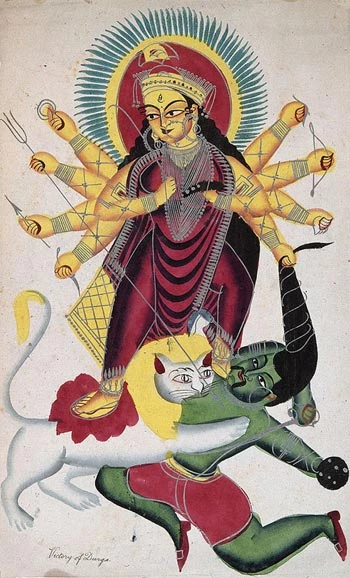Kalighat Icons - Paintings from 19th century Calcutta
The ‘Kalighat’-style paintings at Amgueddfa Cymru were brought over from India at around 1880. They represent a popular Indian art form that had died out by 1940. They are the work of professional artists called ‘patuas’ in Bengali and were sold for the equivalent of a penny each at markets and fairs in and around Calcutta, mostly at the gates of the famous temple at Kalighat, from where the style gets its name.
Storytelling
For centuries in Bengal, travelling professional artists known as &;lsquo;patuas’ or ‘chitrakars’ painted pictures or ‘pattas’ on cloth or handmade paper. These pictures were sewn together to make long scrolls of images. These artists toured rural villages, unrolling the images as they recited or sang the story. Patua families living in rural areas near Calcutta continue the tradition to this day.
Patuas move to the city
By 1806, some patuas had moved to the Calcutta – the biggest bazaar in Bengal. This new urban market had huge potential. In addition to residents, seasonal visitors to Calcutta wanted affordable souvenirs. With cheap machine-made paper and manufactured paints, the essential characteristics of the style emerged. Designs were kept simple, to be repeated as often as required according to the popularity of the picture. As demand increased, the detail in the scrolls was abandoned.
Traditions and religion
Certain Hindu traditions guided the painter. Each Divinity had a particular meditational formula – dhyan mantra – which the painters attempted to produce in line and colour. The traditional stories relate the appearance and actions of the gods and goddesses with their complexions, poses, mounts and weapons, which all had to be drawn correctly.
Hindu images and Muslim festivals
As Calcutta was extremely cosmopolitan, in addition to the Hindu images, the important Muslim festival of Muharram is also represented. It is possible that many Kalighat artists accepted beliefs from both the Hindu and Muslim faiths, as many of the scroll painters still do, having two personal names, one from each tradition.
The origin of the Kalighat Collection
The origin of the collection at the Museum is unknown before 1954. Assuming they form a single group, it is likely that they were acquired in Calcutta some time around 1873. The original owner was possibly French.
A collection now in the Bodleian Library, Oxford, was purchased between 1860 and 1870, and contains similar images. The collection is also similar to the seventy-three items in the Victoria and Albert Museum, London, acquired in India between 1865 and 1893.
The fall of the Kalighat style
1870 seems to have been the time when the popularity of these paintings reached its peak. To speed production, some families tried using a lithographic outline during the 1840s, but did not survive many years. It was the chromolithograph, capable of even brighter colours and a huge print run, which ultimately undercut the hand-painting families and took over the market and by the 1930s this popular art form had died out completely.
Sadly, very few of the thousands of Kalighat pats produced during the nineteenth century survive in India today, either in museums or private collections. They were never bought by the rich, who considered them unworthy of the name of art. In the poorer homes, the lack of protection from both the humid climate and physical damage soon destroyed the inherently weak cheap paper on which the patuas had worked their art.
Further reading
W. G. Archer, Kalighat Paintings, London 1971
Balraj Khanna, Kalighat – Indian Popular Paintings, London, 1993
Hana Knizkova, The Drawings of the Kalighat Style, Prague, 1975





Comments - (1)
Very Informative!!